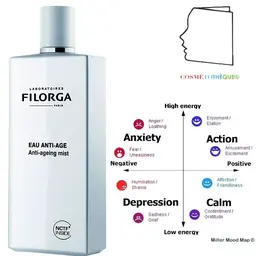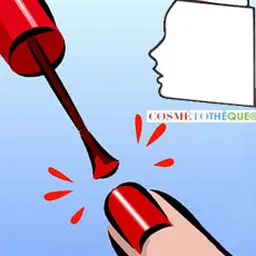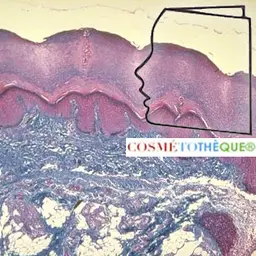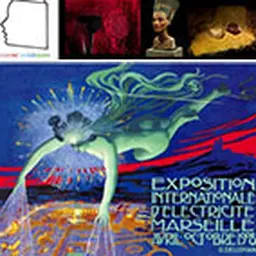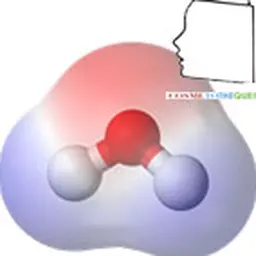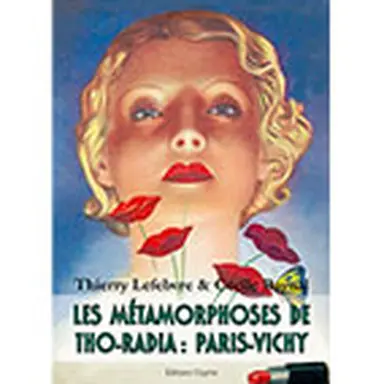
Anyone interested in the world of cosmetics has already seen this emblematic image: the face of a typical platinum blonde from the 1930s illuminated by an open cream jar. A thousand times declined on posters, inserts and other advertising booklets, this young woman was, in the Roaring Twenties, the muse of an astonishing range of cosmetics based on thorium and radium called "Tho-Radia".
By Cécile Raynal and Thierry Lefebvre Cécile Raynal is a doctor of pharmacy, member of the International Academy of the History of Pharmacy. Thierry Lefebvre is a lecturer at the University Paris Diderot and director of the Pharmacy History Review .
To understand how radioactive elements were incorporated into beauty creams with complete impunity, it is essential to recall the permissive historical and legislative context of this period.
The Radium Invasion
After the discovery of radioactivity in 1896 by Henri Becquerel, two young researchers from his laboratory, Pierre and Marie Curie, began systematic research on the minerals at their disposal at the Muséum national d'histoire naturelle in Paris. Their tenacity proved fruitful: in 1898, they discovered a new radioactive element which they named"radium". In a factory in Nogent-sur-Marne made specially available to them by a pharmaceutical company, the two scientists process tons of minerals to obtain a few grams of the precious substance.
In 1901, Henri Becquerel put some of this radium in a tube, which he placed in the inner pocket of his jacket to go to a conference. A few hours later, he feels a skin burn. An informed observer, he understands that the chemical has caused a reaction in his body.
Several doctors and biologists then repeat the experiment and are interested in the action of the new element on living organisms. The idea of introducing radium into therapy was born at the same time and several experiments in hospitals were attempted on skin cancers. Radium is placed in metal tubes (called"Dominici tubes"), or is sometimes glued on canvas to be applied locally on skin lesions. Some doctors then practice what they call"radiumtherapy". One theory flourished at the time: radium would cause necrotizing effects at a weighted dose, while at very low doses it would be exciting.
A pharmacist close to the Curia, Alexandre Jaboin, explores this second hypothesis. In the 1910s, he developed a method that used infinitesimal doses of radium. He calls it"micro-radiumtherapy", then"micro-curiethérapie". This new therapeutic technique,"stimulating cellular functions", is more interesting than the first from a financial point of view, because the quantities of radium required are less, and therefore less costly. Before the First World War, only a small number of pharmaceutical companies developed radioactive specialties. The treatments thus remain confidential and, even if some scientists are aware of the toxicity of the active principle, the legislator does not see the urgency to legislate for some particular cases. After the war, however, these products multiplied.
A Belgian company, the Union Minière du Haut-Katanga, discovered a deposit rich in radium. It exploited it and, from 1923, it began to meet world demand for a price half that of its competitors ! In the mid-1920s, radium-based drugs came onto the market at affordable prices, with pharmaceutical companies claiming to"make therapy accessible to all. Not only is the pharmacopoeia succumbing to this"radium race", but, under various pretexts, all other industries are imitating it. The"all-au-radium" makes its appearance (razor, clothes, etc.).
Cosmetics are also concerned: any cream manufacturer can obtain a few micrograms of radium at little cost and incorporate it into its preparations.
However, the claim of radioactivity is no longer sufficient: the products must be certified! Competition between manufacturers is based on this certification, established by an official laboratory authorised to carry out radioactivity measurements. These are not numerous: in France, only the Curie laboratory can establish this measurement certificate. Several societies requested him but Marie Curie refused to let herself be instrumentalized. Some industries therefore turn to other more or less empowered bodies; others only provide allegations of passage through an official body. The case of Tho-Radia is more particular: it is a beauty cream based on radioactive products developed by a pharmacist.
Tho-Radia
Tho-Radia cream is at the border between healing and skin comfort; its advertisements claim this commercial argument in the formula:"Beautifying because healing". The Parisian pharmacist Alexis Moussalli, at the origin of the range, is a specialist in rare earths; he has already developed gynaecological ova based on thorium and neodymium for the Millot laboratories. His meeting with a certain doctor Alfred Curie (fortuitously homonymous doctor of scholars) was decisive for the continuation of his affairs.
The pharmacist then produces a mixture of thorium chloride (0.50 g), radium bromide (0.25 microg) and excipients (Peru balm, titanium oxide, neutralized saponified stearin), which he calls"Tho-Radia cream". On November 29, 1932, Alfred Curie simply registered the trademark name at the registry of the Seine Commercial Court and authorized the use of his surname to advertise the Tho-Radia cream, supposedly designed"according to the formula of Dr. Alfred Curie". However, the accomplices do not have the necessary funds to promote their invention. They therefore call on SECOR (a Swiss capital company) which is responsible for conducting a massive advertising campaign and is remunerated on sales. These take place exclusively in pharmacies, in order to give a scientific and therapeutic guarantee to the new cosmetic, as explained in a 1933 advertising insert:"The pharmacist's signature on a beauty product constitutes an indisputable guarantee as to the respect of the formula and the therapeutic value of the substances used. On the other hand, the pharmacist alone has the right to sell a beauty cream whose medical properties make it a true pharmaceutical specialty. The success is there.
After many adventures during the Second World War, the Tho-Radia brand survived until the mid-1960s because its creators were able to skilfully comply with all kinds of constraints, particularly when regulating radioactive products.
Late regulation of radium
The proliferation of radioactive products in the 1920s and 1930s led to toxicity studies. On January 1, 1931, a law recognized intoxications caused by X-rays and radioactive substances as an occupational disease. In the mid-1930s, the danger of radium began to penetrate the collective consciousness. The scandal of the"radium-girls" (workers of radium painting victims of maxillary necroses with dinting their brush to the mouth), then the death of the millionaire Eben Byers in 1930 (after an intoxication with Radithor) are there for many.
The French authorities are finally concerned to legislate on the question on the initiative of the physicist Jean Perrin. The process was completed on 9 November 1937: the radioelements of the uranium, radium, actinium and thorium series and their salts, excluding naturally radioactive water and sludge, are classified as"toxic". This entry in"Table A" has the following consequences: - to get them into the pharmaceutical monopoly; - to oblige manufacturers to label the packaging of products containing Poison (which is not the best commercial effect!); - to keep a special register; - to deliver the product only on presentation of a medical prescription.
These constraints become too heavy for a majority of manufacturers who react according to three scenarios. Those who do not belong to the pharmaceutical industry simply abandon the exploitation of these products: exit so the perfumers' beauty creams. Among pharmaceutical companies, a small number respect these measures and continue to discreetly market some radioactive drugs. Third case: the manufacturer removes radioactive substances from its products while retaining the same brand name. The reputation acquired over the years is therefore the only guarantee.
It is this last solution that Alexis Moussalli and SECOR chose to continue marketing Tho-Radia products if they really contained thorium and radium, which is not formally demonstrated !
For more on this subject
- Thierry Lefebvre, Cécile Raynal,
The metamorphoses of Tho-Radia: Paris-Vichy
Éditions Glyphe, Paris, 2013, 210 p.
- Thierry Lefebvre, Cécile Raynal,
From the Institut Pasteur to Radio Luxembourg the amazing history of Tho-Radia
Pharm History Rev.
.
No. 335, 3rd Quarter 2002, pp. 461-480.
- Thierry Lefebvre, Cécile Raynal,
The Tho-Radia Mystery
The Practitioner's Review, Vol. 57, April 30, 2007, pp. 922-925.
- Cécile Raynal, Thierry Lefebvre,
Radium in pharmacies! Part I: pharmaceutical uses of radium before the First World War
Rev. Hist. Pharm. No. 372, 4th Quarter 2011, pp. 431-446.
- Cécile Raynal, Thierry Lefebvre,
Radium in pharmacies! Part II: pharmaceutical uses of radium between the two wars
Pharm History Rev.
.
N°373, 1st quarter 2012, p. 73-86.
- Thierry Lefebvre, Cécile Raynal,
The underside of the Tho-Radia cosmetic range
Pour la Science, n°434, December 2013, p. 70-73.
- Programme France Culture, La Marche des Sciences, by Aurélie Luneau.
Tho-Radia, adventures and misadventures of a miracle cream
October 24, 2013, 14H. 54 minutes.


